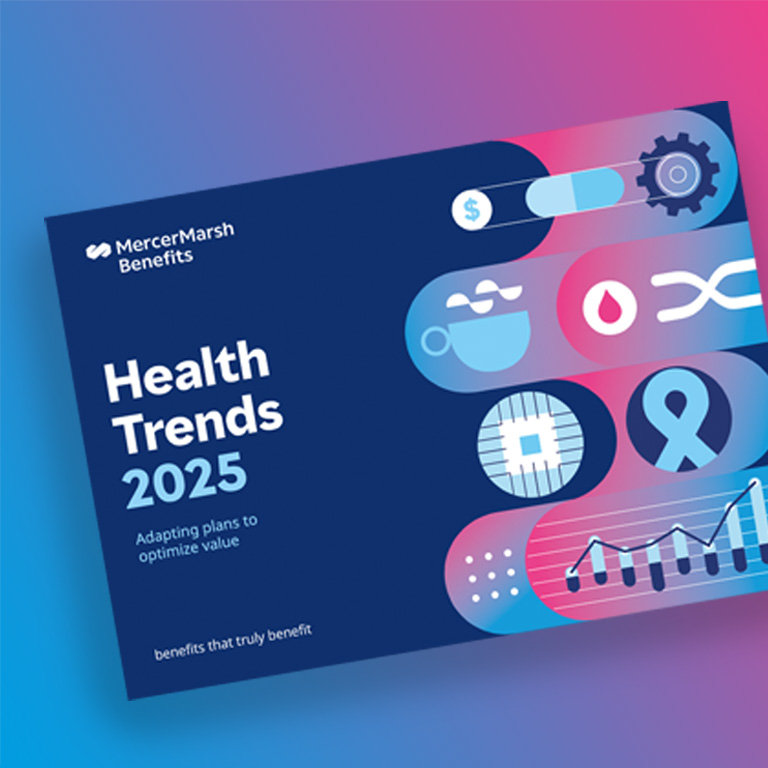
Tony Wood
Senior Partner, Region Leader & Managing Director
However, the triple threat of medical inflation, potentially challenging renewal negotiations and economic uncertainty, means cost containment is high on the corporate agenda. With the C-suite taking greater interest in benefits plan costs, the pressure is mounting on human resources (HR) teams to show value for money.
Despite this, our People Risk 2022 research shows that just 42% of HR and risk managers surveyed currently have an effective cost-containment strategy that combines plan design, health risk management and insurance placement.
Employers should prioritise multiyear and multipronged containment levers that focus on improving employee health while keeping expenditures under control. On its own, cutting coverage to save costs risks a disengaged workforce, increasing the potential for more instances of ill health and leading to low productivity, absence, increasing staff turnover and damaged reputation.
Our Health Trends 2024 research found that medical trend rates are now coming in above pre-pandemic levels, with 2023 global medical trend estimated to be 12.4% and 2024 global medical trend predicted to be 11.7%.
* Rates for 2018-2022 are retrospective. Rates for 2023 and 2024 are prospective. Unweighted global averages used for medical trend.
Several factors are driving higher costs. Global inflation is increasing per-unit costs for services and supplies. Some regions are also seeing higher utilisation patterns due to greater numbers of people accessing services. Globally, nearly two-thirds (62%) of insurers responding to the Global insurer report say changes in treatment mix, such as advancements in technology, are impacting medical cost increases. Finally, conditions that have links to lifestyle changes, such as diseases of the circulatory system and respiratory conditions, continue to be top claims cost drivers.
Economic uncertainty could make renegotiating premiums and communicating these internally more challenging; HR teams will have to answer tough questions throughout the renewal cycle.
Against this economic backdrop, it will be harder to contain costs. At the same time, stripping out benefits to save money may result in key talent moving elsewhere or becoming disengaged. Now, more than ever, employees need help managing wellbeing.
Firms that don’t sufficiently protect their workers will have to address the effects of poor health and increased stress levels. Ignoring these factors could be costly to the business as a result of poor productivity, the need to replace top-tier staff, and the high insurance premiums that come with health conditions that could have been prevented or managed.
Instead of slashing budgets, employers should focus on optimising costs and value for money. This means taking advantage of innovations such as virtual care for conditions like anxiety and achieving the long-term savings that can be gained through creating a culture of health.
At Mercer Marsh Benefits, we believe there are three critical steps employers should take to help achieve successful cost containment.
Benefits programs need to be cost effective, but they should also support employee health. The first step toward achieving this is to examine your plan design and make changes to optimise for value. This means evaluating levers to make sure they’re still fit for purpose.
Where medical inflation is high, deductibles and copays need to be increased to ensure plans work as intended. For example, $10 might have been high enough to cover a typical routine expense when a program was first designed, but it no longer has the desired impact of encouraging responsible utilisation, sharing costs or making employees more cost aware. Generally, we find that claims cost-sharing works when a percentage of the claim amount, rather than a dollar amount, is shared, so that the mechanism continues to work as costs rise (ideally with an out-of-pocket cap to ensure the employee portion of costs remains affordable).
Although cost-sharing is an important part of cost containment, it’s also important to have checks and balances in place to ensure care is affordable for all employees. This means employers will need to think about the impact of these changes on workers earning lower wages.
Employers should consider:
Creating a culture of health and putting prevention measures in place is the next step toward successful cost control.
Our research consistently shows that circulatory, musculoskeletal, gastrointestinal and respiratory conditions continue to drive the top claims in terms of cost and frequency. However, there are simple steps employers can take to help people make lifestyle choices that keep such conditions at bay.
Making sure people obtain comprehensive prenatal maternity care or effectively manage conditions like diabetes or asthma is one way to control short-term costs. Tools to manage risk factors like tobacco or fitness play a greater role in controlling costs down the line while also enhancing quality of life.
Mental health is a growing area of focus. Providing tools and medical services can help employees manage stress, anxiety and depression, leading to a happier, better-engaged and more productive workforce.
A diverse approach to cost containment will be extremely effective in minimising short- and long-term cost increases. However, creating a culture of health that includes communications is paramount to the effectiveness of your programs. Personalised communications targeted for certain demographics will boost the extent to which your programs can relieve pressure on costs.
Employers should consider:
As inflation rises, employers should audit their insurance partners carefully, ensuring that pricing is fair and that terms and conditions are competitive. At renewal, effective negotiations are crucial.
Inefficiency in benefits plans often leads to duplication or gaps in coverage. This can result in wasted money or added costs down the line. Harmonising providers manages this risk while also helping to reduce frictional administrative costs.
Determine whether potential partners will provide the data you need so you can spot claims trends and react appropriately. Weigh the possible cost advantages of moving to a new insurer against the pain points for workers in new claims processes. Some benefits, such as life insurance, are easier to move, whereas others could introduce friction to the employee experience.
Getting this right means working with a trusted broker that understands the market and can identify the best products and solutions — at the right price. The right broker can help you spot emerging risks and look for innovative ways to manage them.
Employers should consider:
HR leaders are under more pressure than ever. While it’s natural to consider cost-cutting as a reaction to medical inflation and uncertain economic conditions, this can have dire consequences for firms. Instead, employers should look at solutions that increase value and ensure workers are well supported, healthy and engaged.
We are facing a long-term shortage and a competitive market for needed skills, and benefits are a critical tool for retaining and attracting talent. But this doesn’t have to lead to bloated budgets. Instead, by designing for value, focusing on prevention and driving efficiency, businesses can balance cost and empathy — looking after their employees as well as the business.

Senior Partner, Region Leader & Managing Director

Health & Benefits Consulting Leader, Mercer Marsh Benefits
Thailand

Article
13/10/2024